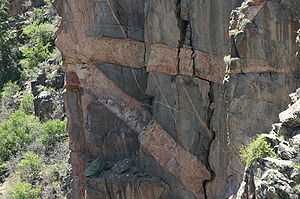Rock and minerals formations
Also see Sedimentary rocks, Metamorphic rocks, Igneous rocks and Precipitate rocks
Essentially all of the worlds surface is made of rock, the rock type in a specific area is dependent on the complex history of the Rock cycle for that area.
In the formation of rocks, there are two main types of substantial formation, they are the Sedimentary and Igneous rock formations. Another minor formation is the Precipitates out of a solution, similar to how salt is formed from saline water. Metamorphic rock is generally made from any of these existing rock formations with the addition of heat and/or pressure.
Igneous rocks
In the first area we will look at different forms of w:Igneous rock formations. These are described as formations that begin as molten rock or w:magmas within the w:asthenosphere that rise up towards and through the w:lithosphere. w:Intrusive rocks either settle beneath the crust or solidifying within the w:country rock (crust) and forming w:plutons. w:Extrusive rock break through the crustal rock and extrude onto the surface of the Earth through w:Volcanoes, w:spreading centres and w:mantle plumes.
Intrusive Igneous rock

For the rest of this page we will be dealing only on this topic and its effects on fossilization.
For a rock to be an intrusive igneous rock or plutonic rock it must have rose up as a magma and solidified at some point within the lithosphere. Igneous rock makes up 95% of crustal rock and are one of the oldest types of rock [1]the main rocks that are formed from intrusion are w:Granite, w:Diorite, w:Gabbro and w:Ultramafic Rocks. Of these the most common type is the Granite rock which is composed of mainly w:potassium and w:silicon rich w:Feldspars and w:quartz. Because intrusive rock is in the lithosphere, the heat release is slow and the magma can cool slowly over thousands to millions of years, the magma slowly forms w:silicate minerals that make up igneous rock and the crystal structure can become quite large if there is enough room [2].
Intrusive rocks are named and classified according to 1. Is the body large ar small? 2.Does it have a particular geometric shape? 3. Did the rock form at considerable depth or was it a shallow intrusion? and 4. What is the geometric relationship of the intrusion to the country rock? (McGeary and Plummer 1994, p.217)
Small intrusive bodies
Dikes, Sills and w:Laccoliths are small but important intrusions. Dikes are discordant and sills are concordant and tubular intrusions, while a laccolith is a domed concordant intrusion. A laccolith is also rare as an intrusion because of the pressure needed to force other rock apart and make its unique shape. These small intrusions are generally offshoots of banoliths and other magmatic hotspots.
Affects of intrusive bodied on fossilization
When an intrusive body penetrates a rock strata like siltstone, shale etc, the effects of heat from the intrusion on the country rock and the fossils it may contain can be drastic. Firstly, any rock directly in contact or within reach of being altered, will destroy any presence of a fossil. For rock that is not directly melted but still receives substantial heat, this rock can be metamorphosed into another type of rock, eg. limestone into marble. This metamorphosing will either distort the fossils appearance or may destroy it.
Readings
- Resources from the central Michigan University
- Rock types and hardness By Kim Brannon
- Igneous Rock by Dave Jessey and Don Tarman
References
- ↑ http://www.usoe.k12.ut.us/curr/science/sciber00/8th/earth/sciber/rocks2.htm
- ↑ http://www.windows.ucar.edu/tour/link=/earth/geology/ig_intrusive.html Intrusive Igneous Rock by Lisa Gardiner Accessed 2008-04-30